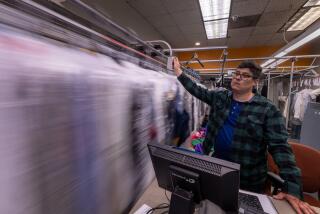Following Raymond Chandler’s L.A. footsteps on his birthday
In 1932, a 44-year-old oil company employee walked out of the Bank of Italy building at the corner of Olive and 7th streets in Los Angeles for the last time. Raymond Chandler had just been fired from his job for the Dabney Oil Company. It seemed he drank too much and had earned a reputation as a womanizer.
Eighty-two years later, the Bank of Italy building at 649 S. Olive is a sealed-off, abandoned shell. The 10-story office building has not yet been swept up in the loft explosion that’s rehabilitated much of the rest of downtown Los Angeles. Its doors are chained, the ground-floor windows sealed off. As for Chandler: Well, he’s gone on to immortality.
Today is Raymond Chandler’s birthday. The icon of noir fiction was born on July 23, 1888 (and died in 1959). He was a late bloomer, his literary masterpieces produced during a second career he began in his mid-40s.
“It was only after he got fired ... that Chandler set about dusting off the literary ambitions he’d begun to cultivate as a young man,” Pico Iyer wrote in a New York Review of Books article on Judith Freeman’s essential biography-cum-travelogue on Chandler, “The Long Embrace: Raymond Chandler and the Woman He Loved.” “He diligently taught himself how to write detective stories by working his way up from pieces for the pulp magazines of the times to short stories and then to a full novel ... ”
Freeman’s 2007 book was my guide (and can be yours) on a brief excursion through a few landmarks from Chandler’s early L.A. life. When Freeman encountered the Bank of Italy building, it looked much as it does today.
The building was “Closed up. Abandoned,” Freeman wrote. But the beautiful doors were intact. “They were worn and neglected against the world, these doors that Raymond Chandler has passed through every working day for the nine years he spent here, but they had not been damaged.”
Leaving Olive Street, I headed to the next stop on my brief Chandler tour: his first L.A. residence, in a neighborhood just east of MacArthur Park. On the way, we passed through John Fante Plaza and over Bunker Hill, where Chandler also lived.
As most L.A. old-timers will tell you, the Bunker Hill of today bears no resemblance whatsoever to the Bunker Hill of Chandler’s day. Back then, it was a faded collection of Victorian residences that had been converted to cheap rooming houses.
Ray worked in a creamery, and his mother at the nearby Grand Central Market (which is still there). Chandler took the Angel’s Flight funicular, which is still visible downtown (though it’s been moved a block south from where it was in Chandler’s day). But all the old rooming houses were demolished in the 1950s and ‘60s to make way for the glass skyscrapers that dominate the L.A. skyline today.
Chandler’s first Los Angeles residence, when he arrived in the city in 1913, was at 613 South Bonnie Brae Avenue, in the district of then tony apartments near MacArthur Park. The young Chandler who lived here, Freeman wrote, was as blunt (and friendless) as his most famous character, the detective Philip Marlowe, would later be.
The neighborhood has undergone many rounds of transformation in the century since. The building where Chandler lived has long since been obliterated. In its place, there was at the time Freeman was writing, a market, a beauty salon and a church. In the years since, those humble business are gone, replaced by the massive new building of an evangelical church.
Down the street, I spotted a building like the one Chandler and his mother might have lived in. Like the old office building on Olive Street, 666 S. Bonnie Brae was shuttered.
“I think this is a dangerous neighborhood,” said my daughter, who was accompanying me on my Chandler search.
“Why do you say that?” I asked.
She responded with the type of observation of gritty, urban life Chandler himself might have made.
“Because that building is covered in barbed wire,” she said.
With that, my L.A. Chandler tour was over. Freeman was more tenacious. She visited most of the two dozen homes Chandler called home.
Follow topics literary @TobarWriter
More to Read
Sign up for our Book Club newsletter
Get the latest news, events and more from the Los Angeles Times Book Club, and help us get L.A. reading and talking.
You may occasionally receive promotional content from the Los Angeles Times.








